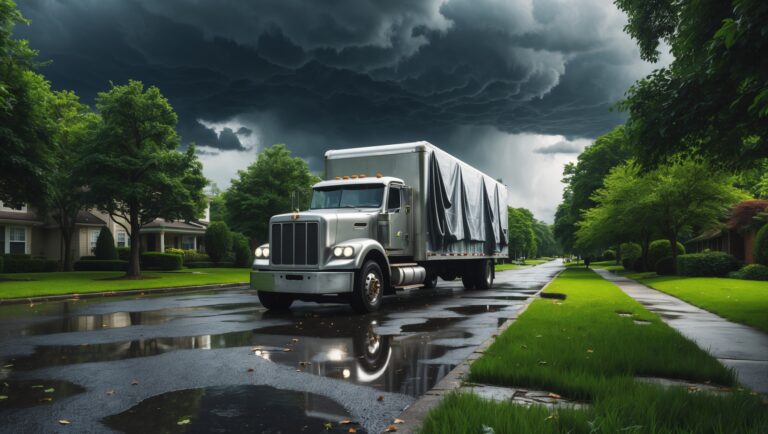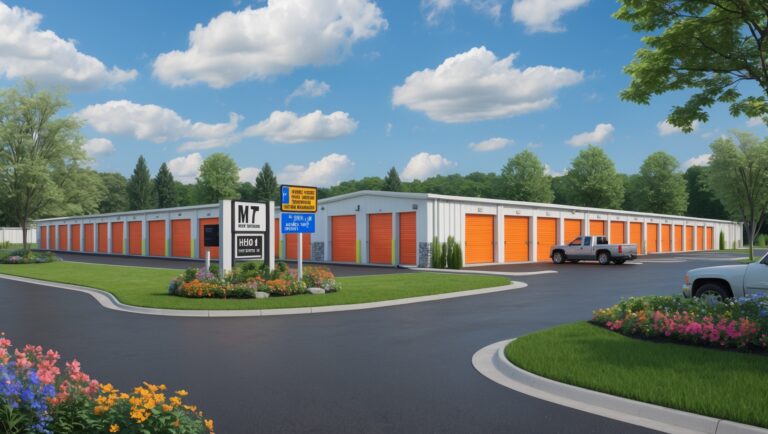Storage Facility Landscaping: Best Practices for Curb Appeal and Low Maintenance
Introduction: Why Landscaping Matters for Storage Facilities
First impressions matter in the moving and storage industry. While security systems, lighting, and unit accessibility are top priorities for owners, the landscaping surrounding your storage facility can be an overlooked asset—or liability. A facility with a neat, attractive exterior not only attracts more customers but also signals professionalism, safety, and care for the property. Well-planned landscaping can deter crime, prevent costly maintenance issues, and even help you comply with local regulations. But unlike residential or office properties, storage facilities have unique needs: high-traffic driveways, limited irrigation, expansive perimeters, and a strict need for low-maintenance solutions. This guide will walk you through the best landscaping practices specifically for storage properties, focusing on curb appeal, minimal upkeep, security, and regulatory compliance. Whether you’re upgrading an existing site or planning a new facility, these tips will help you maximize your property’s value and reputation with smart, sustainable landscaping choices.
Assessing Your Facility’s Landscaping Needs
Understanding Your Site’s Unique Challenges
Storage facilities typically have wide driveways for truck access, tall fencing, and large paved areas. Landscaping must accommodate these functional requirements while enhancing the property’s appearance. Begin your planning with a thorough assessment:
- Perimeter Security: Ensure landscaping does not impede fencing, cameras, or sightlines.
- Water Access: Identify where irrigation is available and where drought-resistant plants are needed.
- Traffic Patterns: Note where customers and moving trucks enter, park, and turn—these areas need durable, low-profile plants and sturdy groundcover.
- Sun Exposure: Map sunny, shady, and wind-exposed spots to help select appropriate plants.
- Local Regulations: Check with municipal or HOA guidelines regarding landscaping, tree removal, water use, and visibility for signage.
Setting Your Landscaping Goals
Decide what matters most for your facility:
- Curb Appeal: Boost your brand image and attract drive-by traffic.
- Low Maintenance: Reduce labor and recurring costs.
- Security: Eliminate hiding spots and maintain clear camera views.
- Environmental Responsibility: Use native plants and minimize water consumption.
- Compliance: Avoid fines and ensure clear emergency access.
Choosing the Right Landscaping Materials
Groundcover and Mulch Options
Traditional grass lawns are rarely practical for storage properties. Instead, opt for:
- Gravel or Crushed Stone: Excellent for high-traffic areas, naturally drains, discourages weeds, and requires little upkeep.
- Rubber Mulch: Long-lasting, doesn’t attract pests, and provides a clean look around signage or entranceways.
- Decomposed Granite: Attractive, firm underfoot, ideal for walkways or borders.
- Native Groundcovers: Hardy, drought-tolerant plants like creeping thyme or sedum provide greenery without frequent mowing or watering.
Plant Selection: Drought-Tolerant and Low-Maintenance
Choose plants that thrive in your climate with minimal attention. Focus on:
- Native Shrubs: Boxwood, juniper, and holly are tough, tidy, and easy to shape.
- Ornamental Grasses: Blue fescue or switchgrass add texture and endure neglect.
- Flowering Perennials: Daylilies, black-eyed Susans, or salvia deliver color without replanting.
- Evergreen Options: Low-growing yews or dwarf conifers provide year-round appeal and require little pruning.
Avoid plants with aggressive root systems (like willows or poplars) that could damage paving or underground utilities.
Hardscaping: Borders, Barriers, and Paths
Use hardscape features for structure and durability:
- Stone Borders: Define planting beds and prevent gravel from spilling onto walkways.
- Concrete or Paver Edging: Keeps mulch and grass contained, reducing trimming needs.
- Decorative Boulders: Block vehicle shortcuts and add visual interest without obstructing visibility.
- Metal or Vinyl Fencing: Choose rust-resistant, low-maintenance materials that blend with your landscaping theme.
Designing for Security and Visibility
Landscaping to Deter Crime
Landscaping choices can enhance your facility’s security:
- Keep Plantings Low: Shrubs near entrances and along perimeters should be trimmed below 3 feet to preserve sightlines for staff and cameras.
- Thorny Barriers: Use prickly plants like barberry or holly under windows or along fences to discourage trespassers.
- Clear Lighting Paths: Ensure that trees and shrubs do not block security lights or camera views, especially at gates and doors.
- Open Layouts: Avoid dense hedges or large trees that could provide cover for intruders.
Enhancing Signage and Wayfinding
Landscaping should highlight your facility’s signage, not obscure it. Design beds and borders to frame signs and direct traffic with:
- Low-Growing Plants: Use flowers or groundcovers that won’t block important directional or branding signs.
- Accent Lighting: Install path lights or uplights to illuminate signs at night without glare.
- Defined Entryways: Use distinct beds or pavers to guide vehicles and pedestrians to the office or main gates.
Water Management and Irrigation Solutions
Smart Irrigation for Minimal Upkeep
Watering is a major maintenance challenge. Consider these options:
- Drip Irrigation: Efficiently waters only the roots, reduces waste, and minimizes weed growth.
- Rain Barrels: Collect runoff from facility roofs to water nearby beds, where allowed by local codes.
- Soaker Hoses: Ideal for long beds along driveways or fences.
- Mulching: Retains soil moisture, further reducing watering needs.
Group plants by water needs (“hydrozoning”) so you can water only where necessary, saving time and money.
Drainage and Erosion Control
Poor drainage can damage landscaping and facility infrastructure. Address these issues by:
- Grading: Ensure soil slopes away from buildings and unit doors to prevent pooling.
- French Drains or Swales: Direct runoff safely away from structures and parking areas.
- Retaining Walls: Use for steep sites to prevent soil erosion and stabilize planting beds.
- Permeable Surfaces: Consider permeable pavers for walkways to let water soak in and reduce runoff.
Seasonal Maintenance Checklist
Spring
- Inspect for winter damage: broken branches, frost-heaved plants, or mulch displacement.
- Prune shrubs and remove debris from beds and walkways.
- Refresh mulch and replenish gravel as needed.
- Test irrigation systems and repair leaks or clogs.
Summer
- Monitor irrigation and adjust watering for heat waves.
- Weed beds regularly to maintain a tidy appearance.
- Trim fast-growing plants to keep sightlines clear.
- Inspect for pest activity, especially near wooden structures.
Fall
- Clear leaves and debris from drains, gutters, and walkways.
- Cut back perennials and remove annuals past their prime.
- Apply a final layer of mulch to protect roots over winter.
- Winterize irrigation systems to prevent freeze damage.
Winter
- Check for ice buildup near entries and paths; add sand or non-corrosive deicer as needed.
- Brush snow off shrubs to prevent breakage.
- Monitor fencing and hardscapes for frost heave or shifting.
Budgeting for Landscaping Upgrades
Initial Installation vs. Ongoing Costs
While some landscaping projects require upfront investment, smart choices can save money over the long run. Factor these costs into your budget:
- Materials: Gravel, mulch, plants, hardscaping, and irrigation supplies.
- Labor: Installation, seasonal maintenance, and occasional repairs.
- Equipment: Consider the cost of hiring vs. purchasing weed trimmers, blowers, or irrigation tools.
- Water: Calculate projected irrigation needs and potential savings from drought-tolerant design.
Many owners recoup landscaping expenses through faster lease-up rates, higher facility values, and reduced vandalism or maintenance costs.
DIY vs. Professional Landscaping Services
Some tasks—like spreading gravel or planting shrubs—are DIY-friendly. More complex jobs (grading, irrigation, hardscaping) may require licensed professionals. Consider:
- Obtain multiple bids for major installations.
- Ask about warranties on plants, materials, and workmanship.
- Verify that contractors carry proper insurance.
- Schedule annual professional checkups for irrigation and tree health.
Compliance and Environmental Responsibility
Municipal Codes and Permits
Many cities have ordinances that affect storage facility landscaping. Common requirements include:
- Minimum green space or tree canopy coverage.
- Restrictions on invasive species.
- Setbacks from property lines or rights-of-way.
- Visibility needs for emergency services.
- Stormwater management and erosion control measures.
Always confirm plans with your local planning department before breaking ground.
Sustainable Landscaping Practices
Demonstrate your facility’s commitment to the environment with these strategies:
- Favor native plants that support local pollinators and require less water.
- Use permeable materials to reduce runoff and recharge groundwater.
- Compost trimmings and leaves on-site if possible; minimize landfill waste.
- Install rain gardens to capture and filter roof runoff in planted beds.
Case Studies: Real-World Storage Facility Landscaping Success
Urban Facility: Maximizing Appeal in Minimal Space
An urban storage operator in Phoenix replaced a patchy lawn with crushed granite, drought-tolerant agave, and solar-powered accent lighting. The result: lower water bills, less vandalism, and a steady increase in walk-in customers impressed by the facility’s modern look.
Suburban Facility: Security-First Planting Plan
A suburban facility in Atlanta worked with a local landscaper to redesign its perimeter beds. By swapping tall hedges for low junipers and adding motion-activated lighting, they improved camera coverage and saw a notable drop in after-hours trespassing.
Rural Facility: Erosion Control and Stormwater Management
In rural Ohio, a storage facility with a sloped lot installed terraced planting beds with native switchgrass and wildflowers. Retaining walls and swales managed heavy rains, preventing costly washouts and boosting the facility’s appeal to eco-conscious renters.
Conclusion: Transforming Your Facility with Smart Landscaping
Landscaping is an often-overlooked but high-impact element of a successful storage facility. By choosing the right plants, groundcovers, and hardscape materials, you can create a first impression that attracts customers, reduces maintenance headaches, and signals security and professionalism. Thoughtful design supports security systems and signage, ensures compliance with local ordinances, and can even lower your facility’s operating costs through water-wise practices. As the storage industry grows increasingly competitive, curb appeal and environmental responsibility are more than just nice-to-haves—they’re powerful differentiators.
Whether you’re managing a single site or a multi-location portfolio, investing in smart, low-maintenance landscaping pays dividends in occupancy rates, property value, and community reputation. Start with a clear assessment of your site’s needs, set strategic goals, and choose materials and plants that deliver both beauty and function. Don’t hesitate to consult with professionals for installation or compliance questions, and always plan for ongoing seasonal care. With the right approach, your landscaping will become a lasting asset to your facility—and a silent partner in your business’s long-term success.





